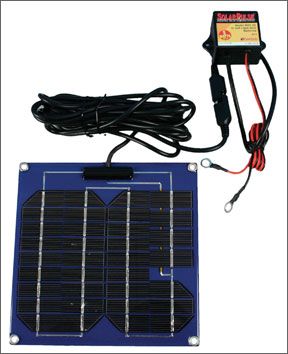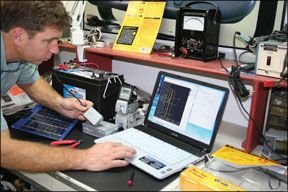With the rising awareness of the new lead-acid battery “Desulfator/conditioner” products that are currently hitting the market, we tested the claims of two leading 288 products to see if they are worth the money. When a lead-acid battery be it a flooded cell, AGM, or gel is discharged lead sulfate is created at the batterys positive and negative plates. When a lead-acid battery is recharged, 100 percent (in theory) of the lead sulfate on the batterys positive plates will convert back into lead dioxide and 100 percent of the lead sulfate on the batterys negative plates will convert back to lead and sulfuric acid. Because the electro-chemical reactions that occur inside of a lead-acid battery are far less than 100 percent efficient, non-conductive lead sulfate that is left behind on the batterys plates will crystallize over a period of time. When a batterys electrode plates are covered with hard lead sulfate crystals, the battery is said to have become sulfated. A sulfated battery will exhibit premature aging and a noticeable reduction in performance and longevity. Pulse Genetech is marketing a compact device called the Nanopulser that attaches directly to a lead-acid battery with just two wires. The Nanopulser PG12N (at right) is the size of a pack of cigarettes, costs about $80, and consumes 20-50mA of battery energy to power its battery conditioning pulse generator. The theory behind the Nanopulsers design is that if a lead-acid battery is subjected to a very weak electrical pulse, 10,000 times per second (10,000 Hz), then detrimental lead sulfate crystals that have accumulated on a batterys electrode plates will slowly decompose and be absorbed back into the batterys component materials. In essence, the sulfate crystals die a death of a 1,000 cuts, or in this case a death of 10,000 cuts per second. 288 Other unique lead-acid battery conditioning products to recently hit the marine market are small, portable solar cell battery chargers produced by a company called PulseTech. The PulseTech products have a 22 Khz DC pulse generator built right into the power module, which aids in conditioning a lead-acid battery. Pulse Tech offers the Solar Pulse line of chargers with integrated pulse technology charging, in both a 2-watt and 5-watt solar version. These compact solar panels are only one-eighth of an inch thick, yet they are extremely rugged. The 2-watt panel ($90) measures a compact 4.75 inches wide and 8.5 inches long (5 Watt: $160; 8.9″W x 8.75″L) and would be an excellent recharging choice for vessels on a mooring or on a trailer that do not have regular access to a 110V AC battery charger. And with the Solar Pulse, you would get the added benefit of built-in battery conditioning, similar to the Nanopulser. Now for the $64,000 question: Do these units work? We ran a short 30-day test of both the Nanopulser and the Solar Pulse on a pair of identical 1-year-old, group 27 flooded cell, lead-acid batteries. At the end of approximately 20 discharge/recharge cycles, our digital conductance battery analyzer measured that the CCA capacity of each battery had increased about 5 percent. To determine durability, both the Nanopulser and the Solar Pulse have been put into longterm testing in Florida. Pulse Genetech, 425/454-2520, Pulse Tech, 800/580-7554, 

Contact
pulsegenetech.co.jp/en
pulsetech.com





































